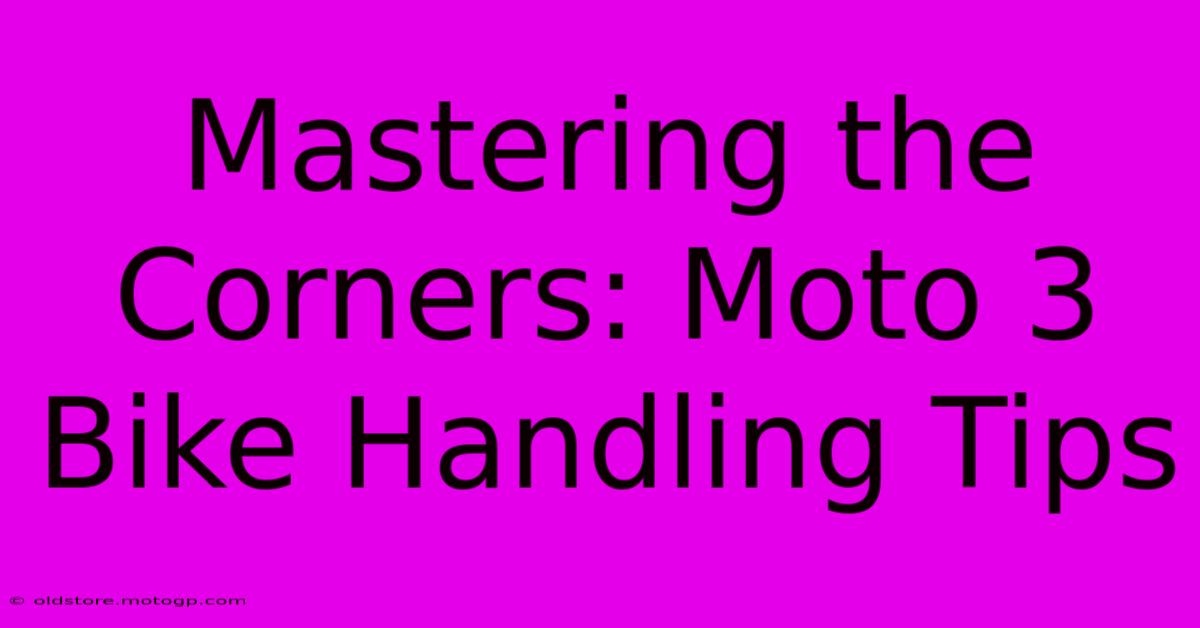Mastering The Corners: Moto 3 Bike Handling Tips

Table of Contents
Mastering the Corners: Moto 3 Bike Handling Tips
Moto3 racing is all about precision and speed, and nowhere is this more crucial than in cornering. Mastering the art of navigating turns smoothly and efficiently is the key to shaving off precious seconds and gaining a competitive edge. This guide delves into the essential techniques for superior Moto3 bike handling in corners.
Understanding the Physics of Cornering
Before diving into specific techniques, it's vital to grasp the fundamental physics at play. Cornering involves a delicate balance between centrifugal force (pushing the bike outwards) and the bike's grip on the track surface. The faster you enter a corner, the greater the centrifugal force, demanding more precise control and a higher degree of lean angle.
Key Factors Affecting Cornering:
- Tire Pressure: Maintaining the correct tire pressure is paramount for optimal grip and consistent handling. Under-inflation can lead to excessive tire deformation and reduced grip, while over-inflation results in a harsh ride and reduced contact patch.
- Suspension Setup: Proper suspension setup significantly impacts cornering stability. A well-tuned suspension absorbs bumps, maintains traction, and allows the rider to smoothly navigate changing track conditions.
- Body Position: Your body position plays a crucial role in maintaining balance and bike control. Leaning into the corner helps lower the bike's center of gravity and improves stability.
- Throttle Control: Smooth throttle application is vital for maintaining traction and preventing wheelspin, especially when exiting corners. A sudden burst of throttle can disrupt the bike's stability and lead to a loss of control.
Techniques for Mastering Moto3 Corners
1. Approaching the Corner: The Setup
- Braking Point: Precise braking is essential. Begin braking before the corner's apex, gradually reducing your speed while maintaining control. Avoid sudden braking maneuvers, as these can destabilize the bike.
- Gear Selection: Choose the appropriate gear before entering the corner to avoid unnecessary shifting during the turn. This allows for better focus on bike control and maintaining a smooth trajectory.
- Line Selection: Choosing the correct racing line is crucial for maximizing speed and efficiency throughout the corner. An optimal line typically involves a smooth entry, apex, and exit.
2. Navigating the Apex: Maintaining Control
- Lean Angle: As you approach the apex, progressively increase your lean angle while maintaining a smooth and controlled throttle. The degree of lean depends on factors such as corner speed, track surface, and tire grip.
- Counter-Steering: Counter-steering is an essential technique that helps initiate and maintain lean. A subtle push on the handlebar in the direction you want to turn helps the bike lean into the corner.
- Body Positioning: Maintain a neutral and balanced body position throughout the corner. Keep your body relaxed and avoid sudden movements that can upset the bike's balance.
3. Exiting the Corner: Accelerating Smoothly
- Throttle Control: As you exit the corner, gradually apply throttle while maintaining a smooth and controlled acceleration. Avoid sudden bursts of throttle, as this can cause wheelspin and loss of control.
- Smooth Transitions: Ensure a smooth transition from lean to upright position. Avoid jerky movements and maintain a fluid riding style to prevent disruptions in traction.
- Maintaining Momentum: Carry momentum through the corner and use it to accelerate smoothly out of the turn. This is vital for setting up for the next section of the track.
Advanced Techniques for Moto3 Cornering
- Trail Braking: This technique involves applying the brakes lightly while the bike is already leaning into the corner. It allows for tighter cornering and improved stability. This requires significant skill and should only be attempted after mastering basic cornering techniques.
- Weight Shifting: Fine-tuning your weight distribution can significantly affect cornering stability. Subtle shifts in weight can help counteract centrifugal force and maintain bike control.
Practice Makes Perfect
Mastering Moto3 cornering requires extensive practice and consistent effort. Start by practicing on a safe track with the guidance of experienced riders or instructors. Focus on developing a smooth and consistent riding style, emphasizing precision over speed. By gradually mastering these techniques and continually refining your skills, you can significantly improve your cornering abilities and enhance your overall performance on the track.

Thank you for visiting our website wich cover about Mastering The Corners: Moto 3 Bike Handling Tips. We hope the information provided has been useful to you. Feel free to contact us if you have any questions or need further assistance. See you next time and dont miss to bookmark.
Featured Posts
-
Understanding The F1 Grid From Formation To Lights Out
Feb 25, 2025
-
Austin Gp 2025 A Spectators Dream
Feb 25, 2025
-
Columbus Sightseeing Made Easy Cota One Day Pass
Feb 25, 2025
-
Get Your Groove On F1 Austin Music Guide
Feb 25, 2025
-
The Formula 1 Austin Map For The Ultimate Fan Experience
Feb 25, 2025
